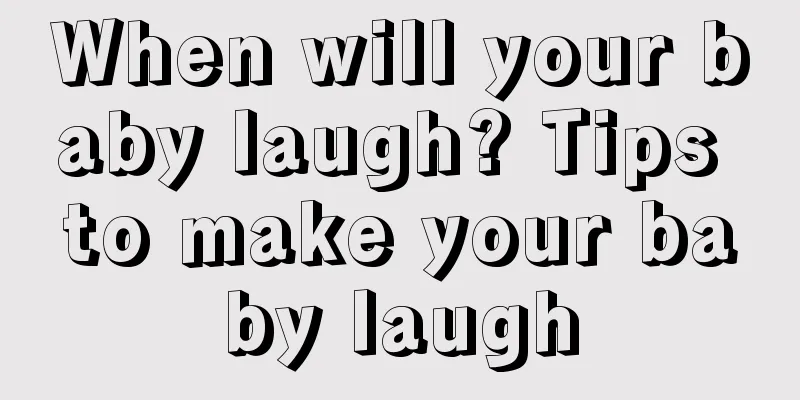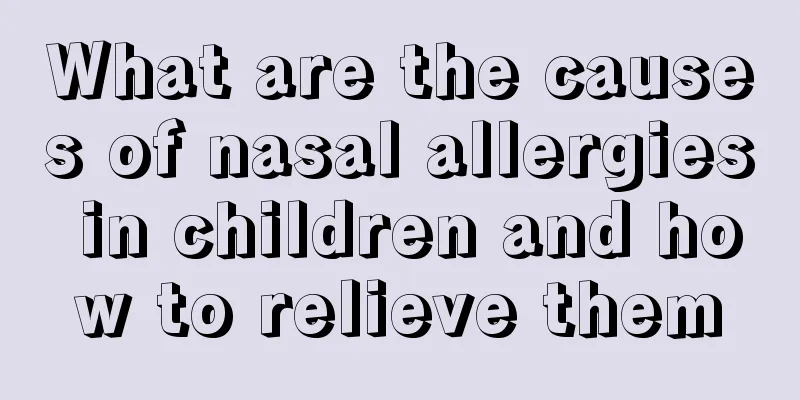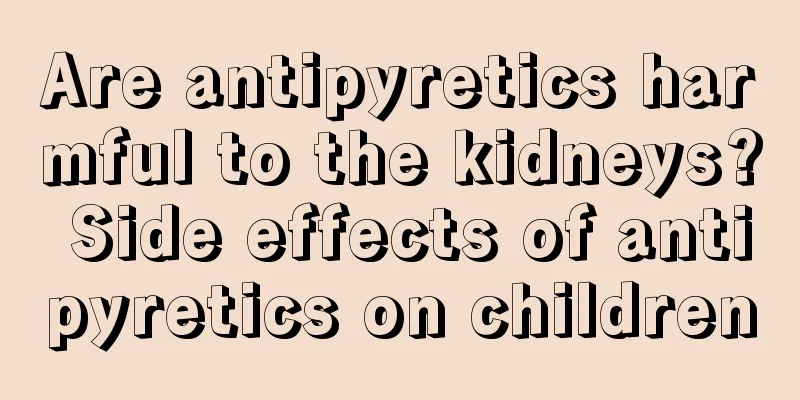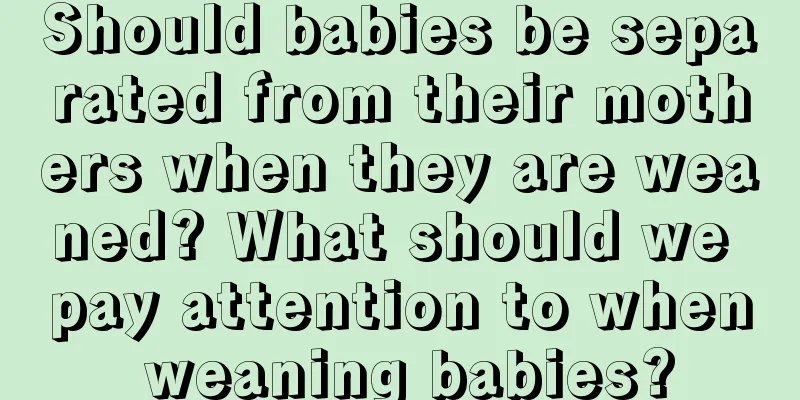When will your baby laugh? Tips to make your baby laugh

A baby's smile is like sunshine, which can make parents and family members happy. So how old will a newborn baby be when he starts to smile? What does a baby's smile at different stages represent? What are some tips to make your baby smile? Let's take a look.When will the baby smile?Spontaneous laughter (0-5 weeks) This kind of smile is often called the "mouth smile" by psychologists. Some studies even suggest that babies will have smile-like facial movements within 2 to 12 hours after birth. This smile usually occurs when the baby is sleeping or sleepy. It appears suddenly and is extremely subtle, even difficult to detect. The most obvious manifestations are: raising the corners of the mouth and moving the muscles around the mouth. When his physiological needs are met, for example, he is full and has enough water, and in a warm environment with soft sunshine and soft and pleasant music, he will smile spontaneously to express the satisfaction of his physiological and psychological needs. Whether the smile at this stage is because the baby feels comfortable, or because of music or physical touch, it is a smile caused by environmental or internal reasons, and is related to the spontaneous discharge of the subcutaneous cortex of the baby's cerebral cortex. But it has no real social significance. One week after birth, the baby will instinctively smile when he is awake, full or hears soft music. At 3 weeks old, babies will naturally smile when they are awake and their bodies are touched by their parents. At 4 to 5 weeks old, babies can also smile when they hear familiar sounds or clap their hands. Unselective social smile (5 weeks to 3.5 months) At this time, the things that are most likely to make babies laugh are people's voices and faces, especially seeing adults nod, smile, and hearing happy voices. By the eighth week, a baby can produce a sustained smile directed at a nonmoving face, but at this point he cannot yet distinguish between the smiles of other people. At 3 months, babies will smile to faces facing them head-on, regardless of whether the face is angry or smiling, but will not respond to faces facing them sideways. The smile at this stage is essentially a reflection of the baby's happy feelings. The baby begins to notice the role of people in the external environment and shows a non-selective social smile: the eyes are particularly bright when smiling, the skin around the eyes is also wrinkled, and the hands and feet are dancing. There are also cooing sounds from the mouth, as if making a "greeting response". If the adult smiles back or "talks" to the baby, it will further stimulate the baby's smile. As this social-behavioral smile develops, another type of smile also begins to develop, a smile that comes from the satisfaction of understanding the world - the cognitive smile. When babies between 7 and 20 weeks old successfully get or regain the attention of others, they will smile shyly. This smile is a kind of satisfaction from the baby's cognition, and they seem to be proud of their ability to command and control. At 3 months old, babies will also smile when they see familiar things. Selective social smile (3.5 months to 12 months) After 3 and a half months, babies are increasingly able to distinguish between familiar faces and other things, and this is when they begin to show selective social smiles. The so-called selective social smiles mean smiling more at familiar people and smiling more freely. This kind of smile is a real smile - a laugh that comes out loud, a joyful and positive smile. Starting from the fourth month when out loud laughter appears, the amount of laughter increases with age. Not only social smiles but also cognitive smiles increase. After 5 months, when babies feel that they have the power to make something happen, they will smile more actively. This smile may not have any social meaning and has nothing to do with anyone. This is the beginning of the typical cognitive smile. In addition to different types of laughter, the stimuli that cause smiling also change as babies age. When they are 4 to 6 months old, tactile stimulation (blowing hair, stroking, etc.) is most likely to make them smile, but as they age, the appeal of this stimulation will decrease. At 7 to 9 months, social stimulation (games such as hide-and-seek) is more likely to cause them to smile than visual stimulation (human faces, etc.). Both of these stimulations cause more smiles than tactile stimulation, but the difference between the two stimulations is not significant. At 10 to 12 months, smiles caused by social and visual stimulation are significantly higher than those caused by tactile stimulation, but at this time there is no significant difference in smiles caused by social and visual stimulation. As development progresses, visual stimulation causes more smiles than social stimulation. During the development process of 4 to 9 months, there is no obvious change in the smile caused by auditory stimulation (such as hearing good music), but at 10 to 12 months, the smile caused by auditory stimulation begins to increase. As these stimuli that elicit social smiles developed, the range of stimuli that elicit cognitive smiles also developed. When babies develop cognitive smiles at 5 months, they smile because they feel they have the ability to control the development of things. When babies grow to 7-9 months, the charm of this sense of control is most obvious. At this time, the feeling developed by babies is a kind of joyful experiential smile; after 8 months, when babies learn new concepts, they will smile more proudly. After that, the baby's smile has more self-cognition. Real smile (after 12 months) After 12 months, babies begin to develop intuitive action thinking, their language skills also develop, and they begin to have the most basic verbal communication skills. Therefore, the baby's social smile and cognitive smile become more differentiated, and the content of the smile becomes richer. The smile of an 18-month-old child begins to carry a positive self-evaluation. By the age of 2, a child's smile is associated with simple humor, and when he sees his mother accidentally spill her milk, he will laugh happily. The smile of a 3-year-old child will have more spiritual value, such as their smile will carry a feeling of pride and love. Research shows that the earlier a baby learns to smile, the smarter he is. Smiling is the most basic human action and the most gentle way to express emotions. Like language, it allows people to communicate and convey emotions. Babies usually smile on the 10th to 20th day after birth or earlier, and laugh out loud around three months old. A baby's smile is the most charming, which will make his parents happy and willing to enjoy the hardship of raising a baby. Ilin Wolf of the United States believes that the earlier a baby learns to laugh, the smarter he is. After follow-up observation, he found that babies who can laugh on the third day have an IQ of 180 when they are 6 years old. What does a baby's smile mean?The baby's smile is mostly a sunny smile. When he is happy, he will open his mouth and laugh, sometimes even laugh out loud. This kind of smile is very contagious, especially for the mother. While laughing, the eyes will focus on the things they are looking at, which makes everyone who sees it feel very happy, as if there are no more troubles in the world. 1. A baby's smile is an instinctive emotional activity, and a smile is a sign of physical comfort. 2. Smiling is the beginning of a baby's interaction with others. 3. Don’t ignore the baby’s smile. Let the baby smile often and thrive in laughter. 4. The most effective way to induce a baby to smile is to let him look at people's faces. 5. It is very important for the mother to respond positively and promptly to the baby's smile. 6. Babies with poor eyesight will start smiling later. 7. The age at which babies learn to laugh is also an important indicator for judging their pronunciation. Tips to make your baby laughHide and seek: The adult covers his face with both hands in front of the baby, then suddenly takes his hands away and makes a "meow" sound. The baby will be surprised and then laugh. Make faces: Make cute and funny faces for the baby as much as possible. The baby will laugh heartily when he sees the faces made by mom and dad. If you can add various interesting actions, the effect will be better. Weird accent: Speak in a weird accent, with exaggerated movements and rich expressions, which will make your baby stare at you and maybe even smile. Babies will love the sounds of mom flicking her tongue, dad whistling or snapping his fingers. Chess and card teacher: Stand head to head with your baby, gently butt each other, and then say: Moo... Pretend that two cows are fighting. The baby will find it very interesting. Ride a horse: Sit on the sofa and let your baby sit on your lap and play the game of riding a horse. The small up and down bumps will make your baby laugh. Grab the handkerchief: Hold the handkerchief or towel within the baby's reach and shake it back and forth to attract the baby to grab it. When the baby is about to grab it, the mother should quickly pull away. If the baby grabs it, he will laugh out loud. |
<<: Sharing of successful experience in preparing for pregnancy
>>: When is the most accurate time for early pregnancy test? When can early pregnancy test be used?
Recommend
Does small breasts mean no milk? Is there a relationship between breast size and low milk production?
Many mothers worry about not having enough milk w...
How to quickly eliminate baby's bloating?
Baby flatulence is one of the most common problem...
The pregnancy test shows that I am not pregnant, but I haven’t had my period. What’s going on?
Pregnancy test sticks are a relatively accurate a...
Are Liby laundry detergent beads effective? Why are there no bubbles in Liby laundry detergent beads?
Nowadays, many people like to put laundry beads i...
How about Blue Moon Aloe Vera Hand Sanitizer? Can Blue Moon Aloe Vera Hand Sanitizer be used by children?
Blue Moon's aloe vera hand sanitizer seems to...
The harm of children's snoring Is children's snoring caused by rhinitis
Snoring in children is a common symptom in daily ...
Is teeth grinding caused by being wronged? Children's psychological condition can also cause teeth grinding
Teeth grinding is a difficult disease to cure, bu...
Baby name naming method, baby girl name with nice meaning is recommended
Every parent wants their baby to have a nice name...
What should I eat when I am older and preparing for pregnancy? How should I adjust my body when I am older and preparing for pregnancy?
Many women, due to work or other reasons, eventua...
What should I do if my child doesn't want to go to school during his rebellious period? What should I do if my child has a bad temper and is irritable during his rebellious period?
Usually, children will go through several stages ...
Can pregnant women eat black olives? Who can't eat black olives?
Black olives are a type of olive, but they are di...
How does postpartum depression occur? Does postpartum depression need treatment?
Postpartum depression is a psychological disease ...
Will Dettol disinfectant discolor clothes? How to use Dettol disinfectant to wash clothes?
The application range of Dettol disinfectant is v...
Wearing underwear incorrectly affects fertility. The correct way to wear underwear
Recently, I was shocked by a hot news that the ch...
Will the baby's spitted milk flow into the ears? What should I do if the baby's spitted milk flows into the ears?
Spitting up milk is a common phenomenon in babies...









